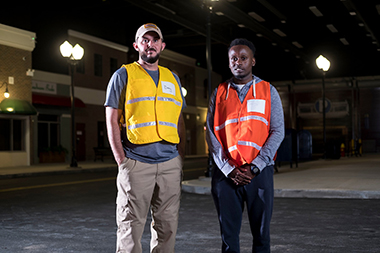CEHC Students, Staff Participate in Disaster Response Exercise
ALBANY, N.Y. (Aug. 15, 2018) – UAlbany’s College of Emergency Preparedness, Homeland Security and Cybersecurity (CEHC) took a lead role last week in training our nation’s future first responders.
CEHC, in partnership with the New York State Division of Homeland Security and Emergency Services, hosted this year’s “NY Hope Disaster Response Exercise” for more than 50 college students at the New York State Preparedness Center in Oriskany, N.Y.
The four-day exercise immersed students in a number of simulated scenarios to prepare them for careers in homeland security and emergency services. It included challenges such as mass causality situations, water rescue operations, wilderness search and rescue, damage assessment and data breaches.
Participants represented 10 universities and colleges from around the country, including 22 students from CEHC, who are required to fulfill 100 hours of non-credit training to complete the college’s undergraduate major.
“We were proud to offer students a crisis simulation experience that introduces them to the challenges that come with responding to a real-world humanitarian disaster,” said UAlbany CEHC Dean Robert Griffin. “This simulation embodies the mission of our college, which is to combine high-quality academics with experiential learning and training opportunities outside of the classroom.”
“Training the next generation of first responders is critically important to preserving the health and safety of New York’s citizens, and the NY Hope exercise offers students real-world disaster response training to help prepare them for future careers in public service,” added Roger L. Parrino Sr., commissioner of the Division of Homeland Security and Emergency Services.
 |
|
CEHC seniors: Doug Clifford (left) and Trevaughn Cummings. (Photo by Patrick Dodson) |
Hands-On Training
Students received classroom training, and were split into teams during simulated scenarios, some serving as emergency personnel, others acting as citizens in need of help. In one scenario, students climbed through makeshift rubble to rescue victims from a collapsed apartment complex. In another, they observed an automobile trying to drive through a simulated washed out road at the facility’s brand new Swift Water Rescue Center.
For Doug Clifford, a second semester senior at CEHC who previously served as a military police officer in the U.S. Army, the training was an opportunity to test what he’s learned – through his personal experiences and the classroom.
“Any time you get to go into the field for a scenario-based simulation, it’s going to better prepare you for the real world,” said Clifford, who is a native of Troy, N.Y. “Each of us brought something different to the table, and we worked together as a team to get through the exercises. This experience is absolutely going to be beneficial for all of us moving forward in our careers.”
Trevaughn Cummings, a CEHC senior from the Bronx, agreed with Clifford. He plans to become a park ranger or join the Transportation Security Administration (TSA) after graduating next May.
“First responders need to be prepared when a disaster strikes,” he said. “Being part of this exercise offered me hands-on experience that I am not necessarily going to get inside of a classroom. I am thankful for [CEHC] offering us this opportunity. It’s helped me to grow stronger as a person and future professional.”
The Hope Program
The Hope disaster training exercise originated 15 years ago in Florida and has since expanded to Missouri and New York. Each location hosts a group of students for a week-long training each year.
New York’s version is offered to students, community and local and state first responders. CEHC, the Consortium for Humanitarian Service and Education, Elmira College and the University at Buffalo sponsor it.
Photos by Patrick Dodson
![]() For more news, subscribe to UAlbany's RSS headline feeds
For more news, subscribe to UAlbany's RSS headline feeds
A comprehensive public research university, the University at Albany-SUNY offers more than 120 undergraduate majors and minors and 125 master's, doctoral and graduate certificate programs. UAlbany is a leader among all New York State colleges and universities in such diverse fields as atmospheric and environmental sciences, business, education, public health,health sciences, criminal justice, emergency preparedness, engineering and applied sciences, informatics, public administration, social welfare and sociology, taught by an extensive roster of faculty experts. It also offers expanded academic and research opportunities for students through an affiliation with Albany Law School. With a curriculum enhanced by 600 study-abroad opportunities, UAlbany launches great careers.


